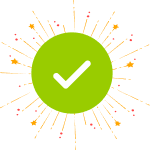Remote sales have become the new norm in the post-COVID world, challenging companies to redefine their sales process and practices for a work-from-home environment.
According to a Hubspot survey, 63% of sales team leaders say that virtual meetings are just as or even more effective than face-to-face meetings.
Selling remotely is more challenging than it sounds. But don't worry. You are not alone in this.
Companies worldwide are adapting to the new normal, and plenty of remote sales techniques are evolving, with best practices emphasizing the importance of a well-coordinated remote sales team and sales process to help you become a pro at it.
Being a pro at remote sales is about more than just mastering the technology and tools you need to do your job.
It's also about developing skills that will allow you to connect with your clients and customers on a deeper level, even when you are not in the same room.
Without further ado, let's dive into remote sales and learn how to become a pro at selling from anywhere, following the best practices for a remote sales team.

Remote Sales Techniques to Boost Remote Sales
Be Respectful of Your Prospects’ Time
Respect your prospects' time by being punctual, prepared, and mindful of the duration of your interactions. Schedule meetings in advance, send reminders, and arrive with a clear agenda.
Focus on addressing their needs directly, avoiding unnecessary information or chatter, which is essential for remote selling efficiency. If you finish early, don't prolong the conversation. Apologize if you need to reschedule or cancel.
Be Genuine and Helpful
Avoid being the salesperson who talks endlessly about their product instead of addressing the prospect's needs. Be genuine and helpful by listening attentively to their problems and focusing on solutions.
Maintain professionalism while interacting, remembering you're not casually chatting with a friend. Be transparent, provide value, and approach each interaction like a valuable treasure hunt, essential advice for every sales process. With these tactics, you'll excel as a remote sales superstar.
Get Comfortable with Virtual Demos
First, testing your microphone, camera, and internet connection ensures everything works. Then, customize your presentation to your audience, keeping it brief, engaging, and ready to handle objections.
Remember to smile and inject personality and humour while staying professional. After the demo, follow up and practice to improve your skills. With these steps, you'll ace virtual demos in no time while avoiding embarrassing mishaps.
Make Recordings of All Your Video Meetings
As a remote sales pro, you probably have countless video meetings. Recording them can be a game-changer. It helps you remember discussions and refine your sales pitch. Plus, we all wish we could redo moments in calls sometimes, a sentiment echoed in the remote sales process.
Also, recordings benefit prospects who may have missed something. It shows you value their time. So, hit record! It enhances your pitch and adds value for prospects. You might even uncover some hidden talents in sound effects!
Prioritize Communication
Clear communication is crucial in remote sales, but it's not always easy. Body language cues can be missed, and internet problems are common.
To keep communication strong, set expectations with your prospects about how often you'll be in touch. And if there's a hiccup in communication, don't avoid it—tackle it together to find a solution, a best practice recommended for remote sales teams.
Be Relentless with Follow-up
As a remote sales pro, you understand the importance of follow-up in sealing deals. Prospects are busy, so gentle reminders can be helpful. Just don't overdo it and come off as creepy.
Mix up your follow-up approaches to keep it fresh and engaging. Who knows? Maybe one day you'll be the lead in a thrilling crime drama suggested as an icebreaker by a skilled sales rep on LinkedIn.
And while it's essential to stay committed to following up, it's equally important to monitor your prospect's responsiveness and adjust your approach accordingly.
If you notice signs that your follow-ups are becoming too frequent or intrusive, it may be time to dial back and reassess your strategy.
Set a Schedule
Remote work offers perks like working in pyjamas but blurs the line between work and personal life. Setting a schedule is crucial to maintain balance, especially for a remote sales team.
Stick to your plan to stay productive and avoid burnout, though flexibility is necessary for life's surprises. Don't forget to take breaks, even if it's just a short dance break.
Communicate your schedule with others to manage expectations. Who knows? You might even host a pyjama-themed dance party with your team and prospects someday, fostering a comfortable and fun relationship.
Make Eye Contact on Video Calls
You get to see your colleagues' and prospects' lovely faces without having to leave the comfort of your home. But it's not just about seeing their faces.
It's also about making eye contact. It shows that you're present and engaged, and it can help build rapport with your prospects. And don't worry if you find looking directly at the camera difficult, a common challenge for sales professionals transitioning to work from home.
You can cheat by positioning the person's video window close to your camera, a handy tip for sales reps engaging in video calls. Ensure you're not staring at your reflection the whole time (we've all been there).
Position your camera and video window in a way that helps you look directly at the person, and don't be afraid to get a little silly with it. And who knows, maybe one day you'll have a virtual staring contest with your prospects and come out on top.
Send an Agenda Before Your Sales Calls
Sending an agenda before your sales calls may seem like a small detail, but it's a game-changer in remote sales. It demonstrates your organization and professionalism, which builds trust with your prospects.
Moreover, it helps set expectations and prepares both parties for productive discussions, avoiding awkward silences.
But here's the kicker – your agenda doesn't have to be dull. Add some humour or personality to make it engaging. Consider including sections like "Small Talk" to bond over shared interests or "Fun Facts" to share interesting tidbits about yourself.
This personal touch makes remote sales more enjoyable and memorable for everyone involved.
Find Creative Ways to Add Personality to Your Communication
Finding creative ways to add personality can help you stand out from the competition and build stronger relationships with your prospects. One way to do this is by using emojis in your emails and instant messages.

But don't go overboard – you don't want to come across as too casual or unprofessional. Instead, use them sparingly to add extra oomph to your messages, maintaining the professional decorum expected of sales managers. For example, you can use a smiley face to show enthusiasm or a thumbs up to show agreement.
Using video messages instead of traditional emails. It allows you to showcase your facial expressions and tone of voice, which can help you connect with your prospects on a more personal level.
Plus, mixing things up and standing out from the crowd is fun. And finally, feel free to let your personality shine through in your sales pitches and presentations.
Share personal anecdotes or crack a joke; by doing so, you'll come across as more authentic and relatable, which can go a long way in building trust with your prospects.
Finding creative ways to add personality to your communication can help you stand out from the competition and build stronger relationships with your prospects.
Use emojis and video messages, and don't be afraid to let your personality shine through in your sales pitches and presentations. After all, remote sales can be fun, too!
Use Tools that Boost Your Productivity
In today's world, we have plenty of tools that can help us work smarter in remote sales. Email is a reliable option for staying organized and managing your inbox efficiently, a cornerstone for any sales professional.
Use email templates and scheduling features to save time and improve response rates.
Task management systems like Trello or Asana can keep you on track by creating to-do lists and prioritizing tasks. Additionally, video conferencing tools like Zoom or Google Meet allow you to connect with prospects and clients easily, saving time and money on travel.
By utilizing these tools effectively, you can boost productivity and success in your remote sales endeavours.
Closely Track Your Customers’ Interest and Interactions
You must have the art of tracking your customers' interests and interactions. But in all seriousness, staying on top of how your prospects and customers engage with your remote sales efforts is crucial.
Doing so can tailor your approach, focus on what works and doesn't, and increase your chances of success.
Thankfully, many tools help you keep track of your customers' interests and interactions. From CRM software to analytics platforms, these tools can provide valuable insights into how your customers interact with your brand.
So, use them wisely and make the most out of the data at your fingertips.
Remember, tracking your customers' interests and interactions is not just about collecting data – it's about using that data to make informed decisions and take action.
So, analyze the data, identify patterns and trends, and adjust your approach accordingly. With Callyzer and other tools in your arsenal, you can turn data into actionable insights and become a pro at successful remote sales in no time.

